Abstract
Safety is crucial to ensure the sustainability of aviation growth. To better clarify the influences of human factors on aviation accident risks, this study developed a hybrid HFACS-BN model (HFACS: Human Factors Analysis and Classification System; BN: Bayesian Network). The authors designed and implemented a questionnaire survey based on the four-level HFACS framework and collected valid data from 180 out of 649 aviation professionals working in the Ulaanbaatar International Airport, Mongolian in 2017. The model identified 35 major human factors out of 129 factors. The model validation was performed in terms of content validity and predictive validity. The results showed that even though a majority of respondents perceived that many human factors had a middle- or high-effect on aviation accident risks, the probability of the risks caused by human factors was estimated to be just 1.37%. The Unsafe Acts level is most influential to the risks among the four levels, while the Unsafe Supervision level contributes least. It is revealed that enhancing aviation professionals’ awareness of human factors should make full use of causal chaining effects among human factors. Finally, this study contributes to the literature from the perspectives of both methodological development and important empirical analysis.
1. Introduction
Safety is crucial to sustainable aviation growth [1]. The overall safety record of commercial aircrafts has been getting better and better in recent years. However, as one of the most crucial issues in the aviation industry, aviation safety has always been the primary concern. Indeed, advanced technologies and well-trained air traffic controllers have improved aviation safety remarkably, while existing studies have continuously emphasized human factors as the main cause of aviation accidents [2]. In this context, human factors sustainability is important, which refers to ‘the development of a working environment, process, and infrastructure that enables the human factors considerations to support the success of operations in the long-term’ [3].
Research on human factors in aviation can be tracked back to the 1940s, when experts recognized the importance of improving essential criteria of selection of flight pilots. Later in the 1960s, human factors in aviation attracted more extensive attention, although only 20% of aviation accidents were thought to be related to human errors at that time and currently the proportion is generally considered to be more than 80% [4]. Various efforts have been made to improve aviation safety by eliminating human errors, and globally, the International Civil Aviation Organization (ICAO) has always been devoted to improving human factors research achievements and adapting the latest ones into the aviation industry.
The history of aviation safety experienced the era of technical factors from the early 1900s to late 1960s, and that of human factors from the early 1970s to mid-1990s, respectively. Recently, organizational factors have become a new concern and safety tends to be viewed from a systemic perspective, including both human and organizational factors as well as other factors [5]. Under this background, an effective tool namely Human Factors Analysis and Classification System (HFACS) was developed and it has been widely applied in aviation operation systems. However, challenges remain since HFACS is a theoretical framework and should be examined based on detailed quantitative data under different contexts. In recent years, research on human factors in aviation has been facing new challenges with the improvement of advanced technologies. In addition, commercial airplanes have adopted three crew members instead of two, and the flight environment has become more and more complicated. Compared with traditional mechanical tools, electronic ones have been widely applied and proven to be more effective.
Previous studies have focused on searching for the origin of aviation accidents, but neglected professional opinions from experienced investigators or operators [6,7]. New theories and methodologies for human factors in aviation have been proposed, such as the SHEL (Software, Hardware, Environment and Liveware) model, Systems Theoretic Accident Modelling and Processes model (STAMP) [8,9], in addition to HFACS. However, their usefulness/effectiveness still needs to be further investigated based on quantitative data and especially, since few studies can be found in the context of developing countries.
Turning the issue back to Mongolia, the target developing country in this study, there were 10 accidents during the period of 1963 to 2016 registered in aviation safety network databases, but only one accident was recorded by ICAO officially [10]. To deal with such rare events, more innovative approaches need to be developed and examined based on empirical data. In line with such consideration, the purposes of this study are to propose a hybrid HFACS-BN model in order to better clarify the influences of human factors on aviation accident risks and to explore more influential factors by reflecting professional knowledge from aviation professionals at the various levels. BN refers to Bayesian Network. Data were collected from 180 Mongolian professionals (out of 649 professionals in the airport) working in the Ulaanbaatar International Airport. To the authors’ best knowledge, this research is the first attempt not only in Mongolia but also in developing countries, as reviewed later. The structure of the remaining part of this paper consists of a literature review, methodology and data, results, discussion, and conclusions.
2. Literature Review
According to ICAO’s definition, studies on human factors examine the interactions between people, machines and each other, and the goal is to make a safe and efficient environment [11]. In fact, human factors in aviation are a complicated concept including human physiology, psychology (perception, cognition, memory, social interaction, error, etc.), work place design, environmental conditions, human-machine interface and anthropometrics. It can also be divided into individual factors and group cooperation factors (i.e., Crew Resource Management, CRM). The Federal Aviation Administration reported that human errors have not decreased over the past few decades and remain a major cause of aviation mishaps [12]. By understanding the details of human information processing, human errors could be further eliminated from aviation operation.
It has long been acknowledged that human performance is not always perfect. Rasmussen first classified human errors into knowledge-based, rule-based and skill-based [13]. Shappell and Wiegmann categorized the errors into skill-based errors, decision errors, and perceptual errors [14]. Decision errors refer to an individual’s conscious decisions/choices, which prove to be inadequate for the current situation. Skill-based errors usually occur during highly routine conditions. The most prevalent skill-based errors include memory lapse and slip of action. Common decision errors include improper procedure or maneuver, misdiagnosed emergency and poor decisions. Perceptual errors occur when an individual is put under an unfamiliar situation, where no referential procedure is provided [15]. Human errors can further be classified from other angles. They can be divided into random errors, systematic errors, and occasional errors based on their statistical features. Random errors are natural errors attributable to random and unpredictable elements. Systematic errors refer to a series of errors in accuracy that come from the same tendency. Occasional errors occur in or after the process of daily operation. Take the landing as an example, random errors occur when a pilot deviates the landing site without predictable patterns. Systematic errors occur when the pilot deviates consistently, which can be predicted but do not happen every time. If a pilot can land well in normal conditions and suddenly makes a mistake, it belongs to occasional errors [16]. Considering detailed forms of errors, human errors include commission errors and omission errors, where the former refers to improper behaviors or irrelevant behaviors, and the latter occurs when necessary procedures or operations are omitted [17]. From the view of consequences, reversible errors and irreversible errors can be distinguished. For instance, if a pilot makes a wrong calculation about time cost for going through a thunderstorm but he realizes it before taking an action, the error is reversible; otherwise, an irreversible result will occur [18].
Due to the unique geographic location, aviation is the primary option for Mongolia to connect to the outside world. Mongolian aviation had a sluggish period in its early development. After World War II, the Council Ministers of the People’s Republic of Mongolia decided to improve the lives of its people and bring the country’s lives from war to peace. The Ministry of Defense made a contract deal with the former Soviet Union for receiving new aircrafts in 1955 and in the next year a new route was opened between Moscow and Ulaanbaatar [19]. After the Air Transport Department was established in 1957, a team of pilots carried out the first international commercial flight between Ulaanbaatar and Moscow with an Illy-shin (IL 14) airplane. Mongolia became a member state of ICAO in 1990 and the International Air Transport Association (IATA) in 1991, and then its civil air transport began to develop with an expansion of relationships connecting to other countries. The Civil Aviation Administration changed its name to the Civil Aviation Authority in 1999. The main goal of the authority is to provide safe, efficient and sustainable civil aviation services by improving the legal environment of the civil aviation field and the quality and accessibility of air navigation services, airport services by implementing policies and regulations to meet international standards [20].
Located between two giant countries, there is potentially increasing demand in air flow; however, the current safety rules and regulations are mainly based on only some documents suggested by ICAO. More detailed safety management specific to Mongolia is needed, for example, paying more attention to obstructions like high mountains and poor weather conditions.
Regarding the applied models in aviation research, it is generally accepted that accidents happen due to complex mechanisms and our understanding of accidents has been improved with the assistance of more and more proposed models.
The SHEL model was proposed by Edwards and modified by Hawkins [21,22]. The name is derived from the initial letters of its components: Software, Hardware, Environment and Liveware. Among the four factors, Liveware (human) is the core of the system. It is also the most important, sensitive and complicated component. The SHEL model acknowledges the interactions between Liveware and the other three components, but the Modified SHEL model further highlights interactive influences of the Liveware-Liveware relationships.
The Reason model, also known as the Swiss Cheese Model, has provided a systematic view for not only human behaviors involving unsafe events but also latent organizational influences on human behaviors. Indirect influences from management, stakeholders and enterprise culture, and so on, are all taken into consideration [23]. Based on large amounts of aviation accident reports, Shappell and Wiegmann proposed the aforementioned Human Factors Analysis and Classification System (HFACS), which defines the holes in the Swiss Cheese Model and further describes the contents of active failures and latent failures [24].
The Systems Theoretic Accident Modelling and Processes model (STAMP), is based on a system theory that each organization contributes to an accident or achieving successful system safety controls. The outstanding point of the model is to account for organizational factors, human errors and adaptations to changes over time. Meanwhile, safety is attained by enforcing safety constraints continuously instead of preventing component failure measures [25,26].
With the above reviews, we found that existing studies could be further improved from the following aspects. First, human errors in aviation should be further explored, especially in the context of developing countries like Mongolia. The number of airline passengers in developing countries has been growing continuously; however, the crash risk of airline transportation in developing countries is 13 times higher than that in USA [27]. Although some typical human errors were identified, more systematic and comprehensive studies are still needed, especially with respect to crucial human factors having higher impacts on aviation safety [28]. Furthermore, a majority of models of aviation human errors analysis emphasize structural or systematic views; however, the arguments need more quantitative investigations, especially in the context of developing countries. Furthermore, how to deal with rare events remains the most crucial issue in aviation safety research, because aviation accidents usually occur with an extremely low rate, but their consequences are extremely serious. Unlike analyses of road accidents with various crash data and methodological approaches, aviation safety research needs more operational survey and innovative modeling methodologies.
3. Methodology and Data
3.1. Human Factors Analysis and Classification System (HFACS)
Based on Reason’s organizational model of human errors, HFACS was originally developed for US naval aviation, and then its developments were described in a series of papers and books. Various failures are divided into active ones and latent ones, where the former addresses front-line operators’ failures while the latter are more dominant in the HFACS framework. It is obvious that the HFACS framework (Figure 1) has built a bridge between theory and practice by accommodating human factors in aviation in a more systematic way [29,30]. The model considers all aspects of human errors, including the conditions of operators and organizational failures. To date, HFACS has been widely applied in aviation, as well as marine and rail accident analysis [31]. Such popularity encouraged us to adopt it for this study.
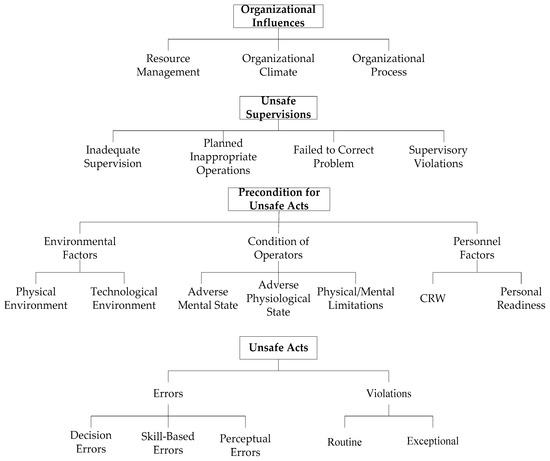
Figure 1.
Human Factors Analysis and Classification System (HFACS) framework.
The HFACS framework is likely to be more reliable due to its taxonomic nature and also more useful in multiple case study analyses [32,33]. HFACS is also in line with the framework of human factors sustainability, which emphasizes that organizational infrastructure, systematic process, measurements and education are four key components for successfully implementing human factors sustainability into aviation ramp operations [3].
HFACS examines human errors at four levels, namely Unsafe Acts, Preconditions for Unsafe Acts, Unsafe Supervisions, and Organizational Influences. The details are described below.
- Unsafe Acts include errors and violations. Human errors have been introduced in the literature review. Violations consist of routine ones (training rules violations, flight manual violations, no authorized approaching behaviors, etc.) and exceptional ones (improper takeoff skills, taking unnecessary risks, no qualified flying, etc.).
- Preconditions for Unsafe Acts address the latent failures within the causal sequence of events as well as more obvious active failures. Environmental factors, conditions of operators and personal factors are considered, respectively.
- Unsafe Supervisions refer to inadequate supervision, planned inappropriate operations, failure to correct problems, and supervisory violations. This level traces the causal chain of events producing unsafe acts up to the front-line supervisors.
- Organizational Influences contain resource management, organizational climate and process. Resource management refers to resource allocation and protection policies of all levels of organizations including personnel, funds, facilities and so on. Organizational climate indicates working atmosphere including various factors affecting personnel performance. Organizational process refers to formal processes (incentive systems, time pressures, schedules, etc.), procedures and oversight within the organization.
3.2. Bayesian Network Model
The BN model, also known as Bayesian model or Bayesian Belief Network (BBN), is a probabilistic directed acyclic graphical model. The structure of a BN model is a directed graph (Figure 2), where the graph nodes reflect the model variables and the links between the nodes reflect the direct variable dependencies [34,35,36].
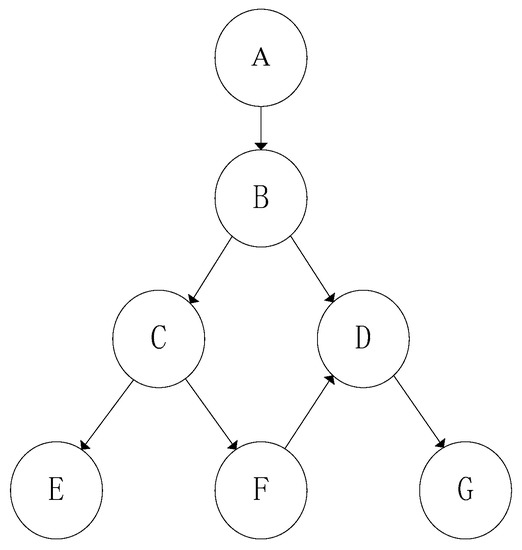
Figure 2.
Bayesian Network (BN) model.
In a BN, any trajectory consists of three variables that are connected in following three forms.
- Serial connection or chain: Connections between A, B, and C are a serial type, corresponding to a joint probability distribution P (Xa, Xb, Xc) = P(Xa) P (Xb | Xa) P (Xc | Xb). For a given condition of Xb, the joint probability of Xa, and Xc is P (Xa, Xc | Xb) = P(Xa) P (Xb | Xa) P (Xc | Xb) / P(Xb).
- Diverging connection or fork: Connections between B, C, and D are a diverging type. It is obvious that variables C and D have a common cause. The joint probability is calculated as P (Xb, Xc, Xd) = P(Xb) P (Xc | Xb) P (Xd | Xb). Then, for a given condition of Xb, the joint probability of Xc, and Xd is P (Xc, Xd | Xb) = P (Xb, Xc, Xd) / P(Xb).
- Converging connection or inverted fork: Connections between B, F, and D are a converging type, where variables B and F have a common result. The joint probability is therefore calculated as P (Xb, Xd, Xf) = P(Xb) P(Xf) P (Xd | Xb, Xf).
According to Bayes’ theory, posterior information can be inferred after prior information is obtained through direct data, literature review or experts’ judgements. The information sources of the BN model can be diverse so that common sense and real-world knowledge can be used to eliminate needless complexity by the model creator [37].
In this paper, BN is used for quantifying the influences of factors identified by the HFACS framework. Due to the aviation accidents data availability, we argue that expert judgments are a more effective way to verify the proposed HFACS-BN model. Professional skills are passed from one generation to the next. Professionals can also learn a lot of practical experience in their daily work. Brooker classified the components of aviation expertise into four categories, namely direct knowledge, indirect knowledge, rules, and integration [38]. Among them, integration is the most important. It is the combination of experts’ overall skills and comprehensive knowledge. Therefore, convinced results can be obtained by taking full advantage of professionals’ integrated knowledge. With such consideration, this study collected data from aviation professionals, which details are explained later.
3.3. Research Framework
Firstly, referring to the mature and developed HFACS structure, a questionnaire was designed for selecting most influencing factors that may cause the aviation accidents. Secondly, a BN model was built according to the literature review, logic knowledge and experts’ suggestions, where conditional probability tables were generated based on the results of the questionnaire survey. The factors selected for the BN model were all from the third-order category, which includes the most concrete questions related to HFACS, as shown in Figure 3. The first-order category refers to the four levels of HFACS and the second-order indicates the subcategories of the first-order. Modeling validation was further conducted (shown in the right side of Figure 3) in terms of content validity and predictive validity.
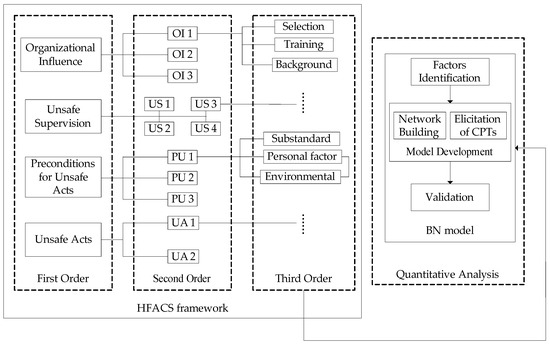
Figure 3.
Research framework.
Although the combination of HFACS framework and BN model has been tried in the previous studies [39,40,41,42], the limitations remain. First, most of the existing studies have only focused on marine systems and specific accident types such as collisions and grounding have been mainly researched, without a comprehensive view. Comprehensive analyses related to aviation accidents and risks cannot be found in the literature. As a result, detailed countermeasures and recommendations to reduce aviation risks are insufficient and less insightful. Modeling validations in the existing studies are not convincible, either.
Therefore, the paper aims to overcome the above issues by reflecting aviation professionals’ awareness about human factors based on their real experience and knowledge within the comprehensive HFACS framework, where various influences are quantified based on the BN model. Such a new perspective is useful to advance aviation research, especially considering the data availability.
3.4. Data Collection
We conducted our questionnaire survey at the Ulaanbaatar International Airport, also known as Chinggis Khaan International Airport. It is situated 18 km southwest of the capital. The passenger flow and freight volume of the airport from 2007 to 2017 are shown in Figure 4, which show a steady increase. In 2017, the airport served over 1.2 million passengers and about 320,000 of them were overseas travellers. As for the detailed accidents, only 10 accidents occurred in the past. In 2012, an aircraft Fokker 50 had diverted from the runway during take-off phase due to sudden wind shear effects and luckily, no injuries were observed.
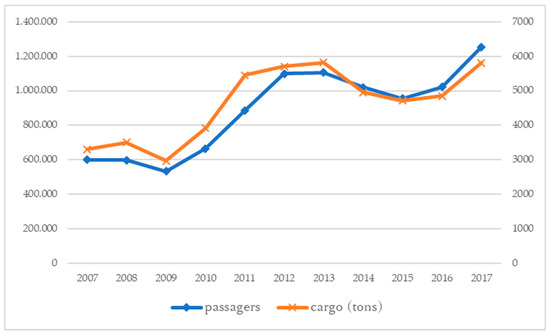
Figure 4.
Passenger flow and freight volume of the Ulaanbaatar International Airport.
The questionnaire was designed mainly based on HFACS, which includes 129 human factors at four levels. It contains 56 questions that are divided into two parts: “Part A: Personal information” and “Part B: HFACS-based questions.” Respondents were asked to evaluate each factor to have a high, middle or low effect on aviation incidents or accidents based on their own professional knowledge and experience. Questions in Part B are further divided into the following three types.
- Type 1 asks respondents to choose a high-, middle- or low-effect of each human factor belonging to the third-order category (Figure 3). This is the main part used for this study.
- Type 2 asks respondents to select three most influencing factors from those included in the second-order category. This is used for factor selection of the BN model.
- Type 3 asks respondents to report their preferences for different types of countermeasures that should be taken (called countermeasure preferences). This is used for the modeling validation.
We conducted the survey on the professionals working at the airport from August to October in 2017. The third author is a professional (an air traffic controller) working at the airport. She studies her master course under the supervision of the second author. With her efforts, we successfully obtained various supports from the airport offices. Furthermore, the following six airlines companies, which represent the Mongolian aviation industry, also kindly cooperated for recruiting the survey respondents.
- Mongolian Airlines—A national flag carrier and commercial airline providing international and domestic flight services.
- Khunnu Airlines—A national commercial airline providing international and domestic flight services.
- Aero Mongolia—A national commercial airline providing international and domestic flight services.
- Blue sky aviation—A private charter flight company (operating under charity purposes from the UK).
- Geosan Aviation—A private charter flight company (operating under geological purposes).
- Sky friends—A general aviation company (the first general aviation company in Mongolia, providing flying clubs for general public).
Each respondent was given a brief instruction at the beginning of the survey and his/her answers were monitored during the whole answering process for avoiding any misunderstandings about the questionnaire. Interviews with those professionals working late nights were especially challenging because they had no fixed working schedules. Nevertheless, we successfully collected valid questionnaire sheets from 180 Mongolia professionals, who were randomly selected from the total number of 649 professionals working in the airport and the above airline companies. These 180 respondents included 74 air traffic controllers, 35 pilots, 22 flight information officers, 22 engineers of communications navigation surveillance, 16 professionals at the manager levels, and 1 other staff. Each interview took about 20 min, on average. The valid sampling rate is 27.73%, which is actually not low as an aviation-related survey.
3.5. Model Development
3.5.1. Network Building
In this paper, the connections between variables in the BN model were decided by literature review and correlation analyses. The coupling relations between variables were first identified using Spearman’s correlation analyses, and then an extensive literature review was conducted to determine the logic influencing sequences of related variables. The resulting network is shown in Figure 5. Obviously, human factors in aviation are tightly coupled and form a complex system. Factors at the Organizational Influences level are on the top of the structure and those at the Unsafe Acts level are at the end. Factors at the Unsafe Supervision level affect factors at the Unsafe Acts level via two routes. The first route refers to the lower part of Figure 5, which shows a sequential influencing structure from “Unsafe Supervision” to “Preconditions for Unsafe Acts.” The second route indicates the upper right part, which shows an intertwined structure between “Unsafe Supervision” and “Preconditions for Unsafe Acts”, where the latter only includes Inadequate Training and Inadequate Experience of Emergency. The factor “Authorized Unnecessary Hazard” at the level of Unsafe Supervision affects the factor “Inadequate Training” at the level of Preconditions for Unsafe Acts, while Inadequate Training influences Poor Crew Pairing at the level of Unsafe Supervision. There are two Unsafe Supervision factors that are directly linked with Unsafe Acts: i.e., from “Failed to Provide Instruction” to “Inadequate Briefing” and from “Failed to Report Unsafe Tendency” to “Violation of SOP” (SOP: Standard Operating Procedures). There are three “Precondition for Unsafe Act” factors showing direct influences on Unsafe Acts: From Loss of Situation Awareness to Overcontrolled Aircraft, from Inadequate Training to Inadequate Ability of Operator, and from Inadequate Experience of Emergency to Violation of SOP. Furthermore, the above second route suggests that Unsafe Supervision and Preconditions for Unsafe Acts have not only sequential effects on Unsafe Acts but also parallel effects.
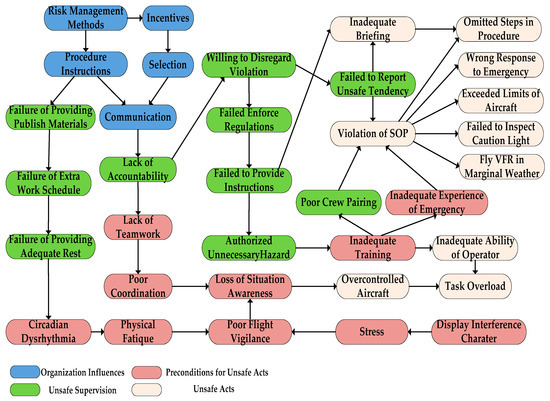
Figure 5.
BN based on HFACS structure.
In order to have a better understanding of the technical terms that are often used in aviation research, factors used in the BN model that are not easily understandable are descripted in Table 1.

Table 1.
Factors description.
The sources of factors and determination of logic sequences are explained in Table 2. It is worth mentioning that some of the logic sequences are derived based on common senses and therefore they are not listed in the table.

Table 2.
Sources of factors and determination of logic sequences.
3.5.2. Prior Probabilities Obtaining
Conditional Probability Table (CPT), also known as “link matrix’, is the contingency table of conditional probabilities stored at each node, containing the probabilities of the node given each configuration of parent values. Before the CPT is filled, conditional probability distributions should be estimated. It is challenging work to get all the conditional probabilities for one node from a database or experts’ opinions when the number of the parent nodes is large. Table 3 shows an example of how the CPT is input.

Table 3.
Example of Conditional Probability Table (CPT) inputting (CPT of ‘selections’ and its parent node ‘Incentives’).
4. Results
4.1. Model Estimation and Marginal Distributions
The model was implemented in Netica software. Based on the modeling estimation results, the probability of aviation accidents caused by the overall human factors is 1.37%. In the survey, each item of human error question has a categorical scale with high-, middle- and low-effect. Different respondents chose different types of the effects based on their own perception. The value 1.37% was calculated by linking all human factors in Figure 5 to the final target variable “Unsafe Acts”, which is the share of all “Unsafe Acts” items with high-effect evaluation answered by respondents. Considering that there are 35 human factors in Figure 5, the resulting 1.37% value is understandable. However, it surely indicates a considerably low association of aviation risks with human factors. This may imply that the 180 respondent professionals in this case study had a quite optimistic attitude towards aviation safety. Turning to marginal distributions of all factors in the above BN analysis, they are displayed in Figure 6. The results show that the shares of middle-effect and high-effect range from 70% to 95%, meaning that the 180 professionals recognized all the factors to be important to aviation safety. Among them, Communication at the Organizational Influences level and Stress at the Unsafe Supervision were identified to have the highest influence on aviation safety.
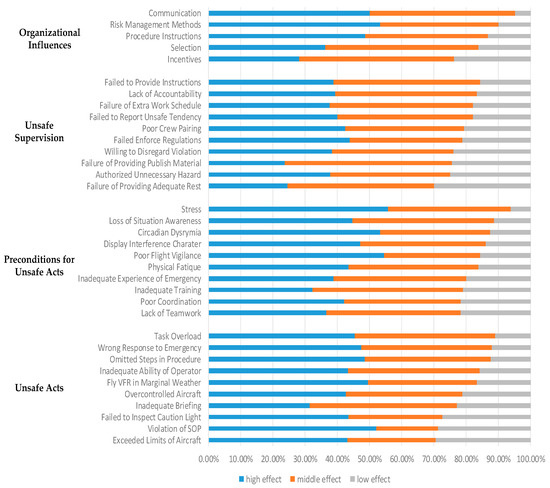
Figure 6.
Marginal distributions of the factors in BN.
Factors perceived by professionals to have a relatively lower influence on aviation safety (i.e., the share of low-effect answers is about 30%) include, “Incentives” at the Organizational Influences level, “Failed to Provide Adequate Rest” at the level of Preconditions for Unsafe Acts, and “Failure of Providing Publish Material” at the level of Preconditions for Unsafe Acts, “Exceeded Limits of Aircraft”, “Violation of SOP”, and “Failed to Inspect Caution Light” at the Unsafe Acts level. Such a lower influence cannot be detected at the Unsafe Supervision level.
Interestingly, Violation of SOP shows an extreme contradiction, which has a higher proportion of both high-effect and low-effect, while the middle-effect share is the lowest. This factor belongs to routine violations at the Unsafe Acts level. It makes sense that these kinds of natural and habitual mistakes are easily neglected or even tolerated by supervisory authorities. The most common case happens when a pilot performs a takeoff under a reluctant condition. Although it will hardly cause an accident, the potential risks indeed exist. The same situation can also be found in “Failed to Inspect Caution Light” and “Exceeded Limits of Aircraft” at the Unsafe Acts level.
As described above, a majority of aviation professionals in this case study had a relatively higher level of attitudes towards aviation safety, because they felt that many human factors investigated in this study are influential to safety. Especially, for most of the factors, their shares with high-effect evaluations ranged from 30% to 50%, implying a relatively pessimistic attitude. In other words, that many professionals were not satisfied with the current situations.
Figure 7 shows the average marginal distributions at the four levels. The Unsafe Supervision level has the lowest influence on aviation safety, while the other three levels show an almost equal contribution to the safety.

Figure 7.
Average marginal distributions by different levels.
4.2. BN Inference
After the BN model was estimated, for capturing the influence of each human factor on overall aviation accident risks, the posterior probability related to each factor was calculated by setting a certain category of the final target variable “Unsafe Acts” in Figure 5 to be one. Here, the value of the high-effect category was replaced by one and as a result, all the posterior probabilities were obtained, as shown in Figure 8. The higher the posterior probability of a factor, the greater the contribution of the factor to the overall perceived accident risk, i.e., the target variable mentioned in Section 4.1.
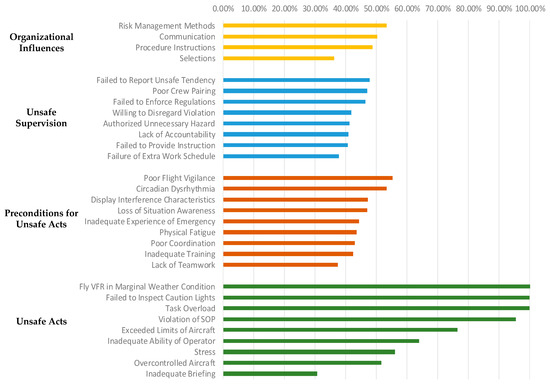
Figure 8.
Posterior probabilities from BN inferences.
Apparently, the Unsafe Acts level contributes most to the overall accident risk, whose four factors (i.e., Fly VFR in Marginal Weather Condition, Failed to Inspect Caution Lights, Task Overload, and Violation of SOP) have a posterior probability larger than 95%. This means that the respondent professionals thought that when an aviation accident occurs, the above human factors may be present, most probably. The second group of factors with larger influence includes Exceeded Limits of Aircraft, Inadequate Ability of Operator, Stress, and Poor Flight Vigilance, whose posterior probabilities range between 55% and 80%. They also belong to the Unsafe Acts level. The contributions of the other three levels to the overall accident risk are similar, ranging between 30% and 60%. Failure of Extra Work Schedule at the level of Preconditions for Unsafe Acts, Lack of Teamwork at the Unsafe Supervision level, Selection at the Organizational Influences level, and Inadequate Briefing at the Unsafe Acts level show the least contribution to the risk (posterior probabilities are less than 40%).
4.3. Model Validation
A BN model is not completed without validation. There are seven ways, in total, of validation [61]. In this study, the following two are applied.
- Content validity: To check content validity, it is necessary to make sure that only relevant factors and relationships are included in the network. In this regard, all the questions included in the survey were designed based on literature review and opinions of some experts in the Ulaanbaatar International Airport, who further provided valuable inputs about the BN structure.
- Predictive validity: This is the most straightforward way to validate the BN model by directly comparing the model results with the data used. It is conducted from the following two aspects in this study.
First, as mentioned in Section 3.4, there were questions of Type 3 designed for countermeasure preferences. Respondents were asked to select three most influential factors that would reduce human errors. Figure 9 shows the countermeasure preferences by the 180 Mongolian aviation professionals. “Improve Human Resource” (chosen by 67.22% of the respondents) was the most preferred countermeasure, followed by “Improve Training” (57.22%) and “Increase Budget” (56.11%). On the contrary, “Follow Operational Manual” and “Promote Decision making skill” were the least preferred measures, chosen by 17.22% and 18.33% of the respondents, respectively. These two factors belong to the Unsafe Supervision level. The above results are roughly consistent with the observations in Section 4.1.
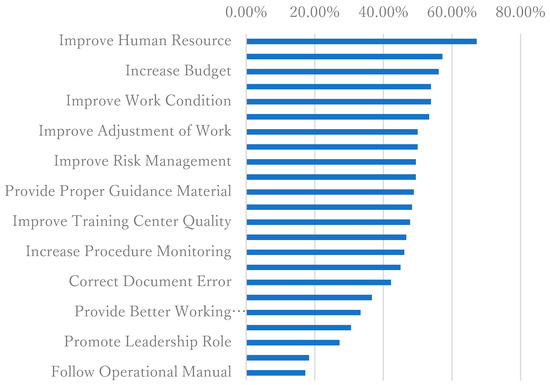
Figure 9.
Countermeasure preferences by aviation professionals.
Second, a sensitivity analysis was conducted to identify how much of the uncertainty of the target variable “Unsafe Acts” (see Section 4.1) can be reduced by each human factor. The uncertainty is quantified as the so-called mutual information, which is based on the entropy concept. The larger the mutual information value of a factor, the more sensitive of the target variable to the factor. Figure 10 only shows the factors with relatively larger values of mutual information. It was found that the target variable is especially sensitive to Omitted Steps in Procedure, Failed to Inspect Caution Light, Wrong Response to Emergency, Task overload, Fly VFR in Marginal Weather Condition, Violation of SOP, and Exceeded Limits of Aircraft. Most of these factors belong to the Unsafe Acts level. This finding is also consistent with the previously-derived observations.
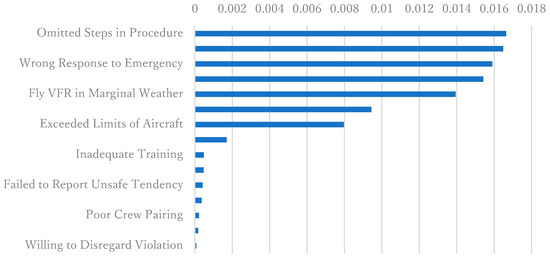
Figure 10.
Mutual information.
5. Discussion
As reviewed in Section 2, traditional accident analysis or risk assessment approaches have difficulties in dealing with rare events related to aviation safety. The incorporation of HFACS into the BN model provides an additional way to identify major human factors that may cause aviation accidents. This study further collected data on how aviation professionals perceived the influences of a variety of human factors. Experienced air traffic controllers can deal with a large number of aircrafts through airspace expeditiously, and well-trained pilots are capable of keeping calm when an emergency happens. The integrated information and knowledge obtained from aviation professionals can provide useful guidance for aviation management and operation, as shown in the previous section. Existing studies have mainly focused on analyses of a single accident and heavily relied on the information collected from a small number of experts. Furthermore, researchers in developed countries have seldom paid enough attention to the issues of aviation in developing countries, probably due to data availability and lack of methodologies suitable to the context of developing countries. This study contributes to the aviation literature from the above methodological and survey perspectives. The efforts in this study provide a new way of thinking about aviation safety research, especially for developing countries.
Various policy implications to the Mongolia aviation management and operation can be derived from this study. Comparing the four levels of the HFACS framework, Organizational Influences, Preconditions for Unsafe Acts, and Unsafe Acts were detected to have almost equal contributions to aviation accident risks. This implies that organizational and individual factors should be emphasized instead of supervision considerations. However, the influences of human factors at each level are largely different from each other. As a whole, four Unsafe Acts factors (Fly VFR in Marginal Weather Condition, Failed to Inspect Caution Lights, Task Overload, and Violation of SOP), Communication at the Organizational Influences level and Stress at the Unsafe Supervision seem most influential to the occurrence of aviation accident risks. Better communication is useful to improve the stressful working environment. As stress may induce more violations, better communication could help to reduce various violations. Thus, effective countermeasures against human errors should be taken by carefully investigating the causal chaining relationships existing in all potential human factors. Moreover, some factors were perceived in a contradictory manner by the professionals, such as Violation of SOP and Exceeded Limits of Aircraft at the Unsafe Acts level, which are easily neglected in some professionals’ daily work, even though many others regarded them to be more influential. All these findings suggest that more research should be done to confirm the robustness of such observations before making sound policy recommendations.
6. Conclusions
This study has presented a hybrid HFACS-BN model accommodating intertwined relationships between a variety of human factors and their associations with risks of aviation incidents or accidents, and examined the modeling validity in the context of a developing country, Mongolia. Data about the awareness of human factors by the aviation professionals working at the Ulaanbaatar International Airport were used to overcome the issues of accident data availability in the aviation research in the context of developing countries.
The survey results confirmed that a majority of respondents evaluated many human factors to have a middle- or high-effect of aviation accidents. Due to this, we expected that human factors would largely affect the perceived accident risks. However, due to the complicated relationships between human factors and their associations with accident risks, as revealed in the structure of Figure 5 and the BN modeling results, the probability of the overall aviation accident risk caused by all the selected human factors in this study was estimated to be just 1.37%. With respect to this low contribution, this study has further identified that the factors at the Unsafe Acts level are most influential to accident risks among all factors at the four levels, and the Unsafe Supervision level has the least influence. All the above observations suggest that aviation safety policies should be made by paying more attention to organizational and individual factors. The revealed complexities in human factors and accident risks further imply that safety-related capacity building for aviation professionals should make full use of causal chaining effects or ripple effects among human factors.
This study contributes to the literature in the following aspects. First, it has provided a systematic and operational approach for aviation safety research by taking advantage of the HFACS framework and BN modeling techniques. Second, it has proposed to make full use of knowledge of aviation professionals to overcome the issues of data availability and to derive effective countermeasures against human errors by considering local contexts. Third, this study has presented unique insights into aviation safety policymaking in the contexts of not only Mongolia but also other developing countries. With the above efforts and findings, this study has emphasized the importance of aviation safety research in developing countries and further paved a new way of implementing relevant aviation safety research.
The modeling and survey approaches in this study can also be applied to non-aviation safety research. For example, logistics and public transport systems may include similar human factors mechanisms related to accident risks, as in this study. Maritime safety research could be further advanced by targeting more accident types and general accident risks. Improving elderly driving safety needs more involvements from governments, communities and family members of the elderly, where the organizational influences treated in this study may become relevant. With the approaches in this study, the above issues could be addressed in a more comprehensive and scientific way.
This study is, however, not free of limitations. As a result, more research should be accumulated in future. First, it is difficult to say that the hybrid HFACS-BN model can be directly used for other cases and it is also difficult to generalize the findings from this study, because of the limited samples. Therefore, both the model and findings need to be verified with more data. Second, expert evaluations were used to assess prior probabilities of root nodes in the BN model; however, they inevitably involve cognitive biases. More suitable survey methods should be developed. Third, the current model presents an influencing sequence from the top “Organizational Influences” level to the bottom “Unsafe Acts” level. However, such sequential influences may change over time, which would lead to inverse sequences. Accordingly, the survey designed in this study should be implemented over time for monitoring the changes in professionals’ awareness and causalities associated with various human factors. Fourth, the observed extremely low contribution of perceived human factors to overall accident risks may be partially attributable to very limited aviation accidents recorded and shorter history of the aviation industry in Mongolia. To clarify this, it is necessary to collect data about the influences of experience of aviation accidents, accumulation of collective knowledge about aviation safety as a country, and capacity building activities of aviation professionals, in addition to human factors. Finally, for transferring more useful know-hows from developed countries to developing countries, it is worth comparing human factors in these two types of countries.
Author Contributions
The authors confirm contribution to the paper as follows: study conception and design: T.Z., J.Z.; data collection: T.Z., D.B.; analysis and interpretation of results: T.Z., D.B.; draft manuscript preparation: T.Z., J.Z., D.B. All authors reviewed the results and approved the final version of the manuscript.
Funding
This research was funded by the Grants-in-Aid for Scientific Research (A), Japan Society for the Promotion of Science (No. 15H02271) and The Project for Human Resource Development Scholarship (JDS), Japan International Cooperation Agency (JICA).
Acknowledgments
The authors would like to thank China Scholarship Council for their financial support to this research. The authors would also like to thank the data support of Civil Aviation Authority of Mongolia.
Conflicts of Interest
The authors declare no conflict of interest.
References
- The 67th Special Meeting of the Directors General of Civil Aviation for the European Civil Aviation Conference. Available online: https://www.traveldailynews.com/post/continued-enhancement-to-safety-key-to-sustainability-of-aviation-growth-in-europe (accessed on 24 November 2018).
- Chang, Y.H.; Yeh, C.H. Human performance interfaces in air traffic control. Appl. Ergon. 2010, 41, 123–129. [Google Scholar] [CrossRef] [PubMed]
- Hubbard, S.M.; Lopp, D. An integrated framework for fostering human factor sustainability and increased safety in aviation ramp operations. J. Aviat. Technol. Eng. 2015, 5, 44–52. [Google Scholar] [CrossRef]
- Chang, Y.H.; Wang, Y.C. Significant human risk factors in aircraft maintenance technicians. Saf. Sci. 2010, 48, 54–62. [Google Scholar] [CrossRef]
- Xiong, C.; Beckmann, V.; Tan, R. Effects of infrastructure on land use and land cover change (LUCC): The case of Hangzhou International Airport, China. Sustainability 2018, 10, 2013. [Google Scholar] [CrossRef]
- Liang, G.F.; Lin, J.T.; Hwang, S.L.; Wang, E.M.; Patterson, P. Preventing human errors in aviation maintenance using an on-line maintenance assistance platform. Int. J. Ind. Ergon. 2010, 40, 356–367. [Google Scholar] [CrossRef]
- Shappell, S.; Wiegmann, D.A. A methodology for assessing safety programs targeting human error in aviation. Int. J. Aviat. Psychol. 2009, 19, 252–269. [Google Scholar] [CrossRef]
- Salmon, P.M.; Cornelissen, M.; Trotter, M.J. Systems-based accident analysis methods: A comparison of Accimap, HFACS, and STAMP. Saf. Sci. 2012, 50, 1158–1170. [Google Scholar] [CrossRef]
- Li, W.C.; Harris, D. Identifying training deficiencies in military pilots by applying the human factors analysis and classification system. Int. J. Occup. Saf. Ergon. 2011, 9, 3–18. [Google Scholar] [CrossRef] [PubMed]
- 2012 Safety Report. Available online: https://www.icao.int/safety/Documents/ICAO_SGAS_2012_final.pdf (accessed on 24 November 2018).
- ICAO. Human Factors Guidelines for Aircraft Maintenance Manual, 1st ed.; Doc. 9824-AN/450; International Civil Aviation Organization: Montreal, QC, Canada, 2003. [Google Scholar]
- Federal Aviation Administration. Aviation Maintenance Handbook-General-Addendum; Federal Aviation Administration: Washington, DC, USA, 2011.
- Rasmussen, J. Human errors: A taxonomy for describing human malfunction in industrial installations. J. Occup. Accid. 1982, 4, 311–333. [Google Scholar] [CrossRef]
- Shappell, S.; Wiegmann, D.A. A Human Error Approach to Aviation Accident Analysis: The Human Factors Analysis and Classification System; Ashgate Publishing: Surrey, UK, 2012. [Google Scholar]
- Latorella, K.A.; Prabhu, P.V. A review of human error in aviation maintenance and inspection. Int. J. Ind. Ergon. 2000, 26, 133–161. [Google Scholar] [CrossRef]
- Chang, Y.H.; Wong, K.M. Human risk factors associated with runway incursions. J. Air Transp. Manag. 2012, 24, 25–30. [Google Scholar] [CrossRef]
- Bella, R.L.F.; Quelhas, O.L.G.; Ferraz, F.T.; Bezerra, M.J.S. Workplace spirituality: Sustainable work experience from a human factors perspective. Sustainability 2018, 10, 1887. [Google Scholar] [CrossRef]
- Li, W.C.; Harris, D. Pilot error and its relationship with higher organizational levels: HFACS analysis of 523 accidents. Aviat. Space Environ. Med. 2006, 77, 1056–1061. [Google Scholar] [PubMed]
- MIAT Mongolian Airlines, History. Available online: https://www.miat.com/pagecontent.php?lang=en&pageId=73 (accessed on 24 November 2018).
- Flight Standards & Operations Oversight Division. Available online: http://mcaa.gov.mn/?p=1385&lang=en (accessed on 24 November 2018).
- Edwards, E. Man and machine: Systems for safety. In Proceedings of British Airline Pilots Association Technical Symposium; British Airline Pilots Association: London, UK, 1972. [Google Scholar]
- Hawkins, F.H. Human factors education in European air transport operations. In Breakdown in Human Adaptation to Stress-Towards a Multidisciplinary Approach; The Commission of the European Communities: The Hague, The Netherlands, 1984. [Google Scholar]
- Reason, J.T. Human Errors; Cambridge University Press: New York, NY, USA, 1990. [Google Scholar]
- Shappell, S.A.; Wiegmann, D.A. Applying reason: The Human Factors Analysis and Classification System (HFACS). Hum. Factors Aerosp. Saf. 2001, 1, 59–86. [Google Scholar]
- Leveson, N. A new accident model for engineering safer systems. Saf. Sci. 2004, 42, 237–270. [Google Scholar] [CrossRef]
- Allison, C.K.; Revell, K.M.; Sears, R.; Stanton, N.A. Systems Theoretic Accident Model and Process (STAMP) safety modelling applied to an aircraft rapid decompression event. Saf. Sci. 2017, 98, 159–166. [Google Scholar] [CrossRef]
- Airline passengers in developing countries face 13 times crash risk as US. Available online: https://www.sciencedaily.com/releases/2010/09/100901132235.htm (accessed on 24 November 2018).
- Alvarenga, M.A.B.; Melo, P.F.F.; Fonseca, R.A. A critical review of methods and models for evaluating organizational factors in Human Reliability Analysis. Prog. Nuclear Energy 2014, 75, 25–41. [Google Scholar] [CrossRef]
- Zhao, H.; Zhang, N.; Guan, Y. Safety Assessment Model for Dangerous Goods Transport by Air Carrier. Sustainability 2018, 10, 1306. [Google Scholar] [CrossRef]
- Celik, M.; Cebi, S. Analytical HFACS for investigating human errors in shipping accidents. Accid. Anal. Prev. 2009, 41, 66–75. [Google Scholar] [CrossRef] [PubMed]
- Madigan, R.; Golightly, D.; Madders, R. Application of Human Factors Analysis and Classification System (HFACS) to UK rail safety of the line incidents. Accid. Anal. Prev. 2016, 97, 122–131. [Google Scholar] [CrossRef] [PubMed]
- Gaur, D. Human Factors Analysis and Classification System applied to civil aircraft accidents in India. Aviat. Space Environ. Med. 2005, 76, 501–505. [Google Scholar] [PubMed]
- Daramola, A.Y. An investigation of air accidents in Nigeria using the Human Factors Analysis and Classification System (HFACS) framework. J. Air Transp. Manag. 2014, 35, 39–50. [Google Scholar] [CrossRef]
- Groth, K.M.; Mosleh, A. Deriving causal Bayesian networks from human reliability analysis data: A methodology and example mode. Proc. Inst. Mech. Eng. Part O J. Risk Reliab. 2012, 226, 361–379. [Google Scholar] [CrossRef]
- Ghasemi, F.; Sari, M.H.M.; Yousefi, V.; Falsafi, R.; Tamošaitiene, J. Project portfolio risk identification and analysis considering project risk interactions and using Bayesian Networks. Sustainability 2018, 10, 1609. [Google Scholar] [CrossRef]
- Xia, N.; Zou, P.X.W.; Liu, X.; Wang, X.; Zhu, R. A hybrid BN-HFACS model for predicting safety performance in construction projects. Saf. Sci. 2018, 101, 332–343. [Google Scholar] [CrossRef]
- Sitthi, A.; Nagai, M.; Dailey, M.; Ninsawat, S. Exploring land use and land cover of geotagged social-sensing images using naive Bayes Classifier. Sustainability 2016, 8, 921. [Google Scholar] [CrossRef]
- Brooker, P. Experts, Bayesian belief networks, rare events and aviation risk estimates. Saf. Sci. 2011, 49, 1142–1155. [Google Scholar] [CrossRef]
- Akhtar, M.J.; Utne, I.B. Human fatigue’s effect on the risk of maritime groundings—A Bayesian Network modeling approach. Saf. Sci. 2014, 62, 427–440. [Google Scholar] [CrossRef]
- Chauvin, C.; Lardjane, S.; Morel, G.; Clostermann, J.P.; Langard, B. Human and organisational factors in maritime accidents: Analysis of collisions at sea using the HFACS. Accid. Anal. Prev. 2013, 59, 26–37. [Google Scholar] [CrossRef] [PubMed]
- Mkrtchyan, L.; Podofillini, L.; Dang, D.N. Bayesian belief networks for human reliability analysis: A review of applications and gaps. Reliab. Eng. Syst. Saf. 2015, 139, 1–16. [Google Scholar] [CrossRef]
- Yıldırım, U.; Başar, E.; Uğurlu, O. Assessment of collisions and grounding accidents with human factors analysis and classification system (HFACS) and statistical methods. Saf. Sci. 2017. [Google Scholar] [CrossRef]
- ICAO. Procedures for Air Navigation Services—Air Traffic Management, 16th ed.; Doc. 4444; International Civil Aviation Organization: Montreal, QC, Canada, 2003; ISBN 978-92-9258-081-0. [Google Scholar]
- Okoye, P.V.C.; Ezejiofor, R.A. The effect of human resources development on organizational productivity. Int. J. Acad. Res. Bus. Soc. Sci. 2013, 3, 397–408. [Google Scholar] [CrossRef]
- Ekwoaba, J.O.; Ikeije, U.U.; Ufoma, N. The impact of recruitment and selection criteria on organizational performance. Glob. J. Hum. Resour. Manag. 2015, 3, 22–33. [Google Scholar]
- Eurocontrol. Air Ground Communication Safety Study: An analysis of Pilot-controller Occurrences, 1st ed.; European Organization for the Safety of Air Navigation: Brussels, Belgium, 2004. [Google Scholar]
- ICAO. International Standards and Recommended Practices, Aircraft Accident and Incident Investigation, 2nd ed.; Annex. 13; International Civil Aviation Organization: Montreal, QC, Canada, 2013. [Google Scholar]
- NTSB. (An Independent United States Federal Government Agency) NTSB-AAR-82-08; National Transport Safety Board: Washington, DC, USA, 1982.
- AAIB of UK. Bulletin, Registration Code of Accident: D-ITAN and TC-JJA; Aviation Accident Investigation Bureau of United Kingdom: Farnborough, UK, 2010.
- IFALPA. Fatigue Management Guide for Airline Operators, 2nd ed.; International Federation of Airline Pilots’ Association: Montreal, QC, Canada, 2015. [Google Scholar]
- FSF. ALAR, Approach-and-Landing Accident Reduction. In Briefing Note 2.1: Human Factors; Flight Safety Foundation: Alexandria, VA, USA, 2009. [Google Scholar]
- Federal Aviation Administration, USA. Introduction to TCAS II, Version 7.1; Federal Aviation Administration: Washington, DC, USA, 2011.
- Endsley, M.R.; Rodgers, M.D. Attention distribution and situation awareness in air traffic control. Proc. Hum. Factors Ergon. Soc. Ann. Meet. 1996, 40, 82–85. [Google Scholar] [CrossRef]
- ATSB. Australian Transport Safety Investigation Report. In Aviation Safety Research and Analysis Report 20050342: Perceived Pilot Workload and Perceived Safety of RNAV (GNSS) Approaches; 2006. Available online: https://www.atsb.gov.au/media/32628/20050342_rnav_12.06.pdf (accessed on 29 November 2018).
- BFU. German Federal Bureau of Aircraft Accident Investigation Report: BFU 15-1354-AX; Bundesstelle für Flugunfalluntersuchung: Braunschweig, Germany, 2015. [Google Scholar]
- TSBC. Aviation Investigation Report A14W0127; Transportation Safety Board of Canada: Gatineau, QC, Canada, 2014.
- SHK. The Swedish Accident Investigation Authority; Final Report RL; Statens Haverikommission: Stockholm, Sweden, 2017. [Google Scholar]
- ICAO. Human Factors Training Manual; International Civil Aviation Organization: Montreal, QC, Canada, 1998. [Google Scholar]
- Yang, K.; Tao, L.Q.; Bai, J. Assessment of flight crew errors based on THERP. Procedia Eng. 2014, 80, 49–58. [Google Scholar] [CrossRef]
- Xie, G.; Zhang, X.; Gao, H.; Qian, L.; Wang, J.; Ozguner, U. Situational assessments based on uncertainty-risk awareness in complex traffic scenarios. Sustainability 2017, 9, 1582. [Google Scholar] [CrossRef]
- Pitchforth, J.; Mengersen, K. A proposed validation framework for expert elicited Bayesian Networks. Expert Syst. Appl. 2013, 40, 162–167. [Google Scholar] [CrossRef]
© 2018 by the authors. Licensee MDPI, Basel, Switzerland. This article is an open access article distributed under the terms and conditions of the Creative Commons Attribution (CC BY) license (http://creativecommons.org/licenses/by/4.0/).